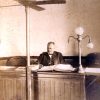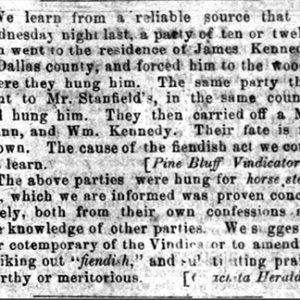calsfoundation@cals.org
James Kennedy (Lynching of)
James Kennedy was a white man lynched in Dallas County in 1866, apparently for his open Unionist leanings. His murder shows the risks that many people who had allied with the Union during the Civil War faced in parts of Arkansas in the immediate postwar period, when pro-Confederate vigilantes perpetrated with impunity a number of assassinations and attacks under the guise of lawfulness.
The August 3, 1866, lynching of forty-four-year-old James Kennedy and other men made news in the August 10, 1866, Little Rock Daily Gazette (under which name the Arkansas Gazette then operated) as follows: “We learn from a reliable source that on Wednesday night last a party of ten or twelve men went to the residence of James Kennedy, in Dallas County Ark., and forced him into the woods, where they hung him. The same party then went to Mr. Stanfield’s home in the same county, and hung him. They then carried off Mr. Munn and William G. Kennedy. Their fate is not known. The above parties were hung for horse stealing which we are informed was proven conclusively, both from their own confessions and the knowledge of other parties.” William G. Kennedy, for reasons unknown, was not hanged.
Additional information about the lynching of James Kennedy comes from the Southern Commissions Claims Records of Green v. Childers, Claim no. 6402, in which twenty-three-year-old James Kennedy, stepson and nephew of the lynched man, shares his remembrance of the event. (The younger James Kennedy’s father was John Kennedy, brother to James. The circumstances of John’s demise are unknown, but his widow Permelia married James, hence the stepson/uncle relationship.) The younger James Kennedy described his stepfather/uncle as a “strong Union man” who was “hung by a party of rebels who took him out at night and hung him. He was an officer of a federal company.” The younger James also describes his stepfather/uncle as one of the four Union votes cast in the township.
The Arkansas State Archives hold an additional source explaining the political climate of the Dallas County area where the Kennedy family resided and describing James Kennedy’s political affiliation. In the document, James Kennedy was described as an ex-member of the “Loyal State” legislature. The mob who took Kennedy into the woods was a “mob calling themselves a vigilance committee,” and no steps were taken to arrest the individuals.
The archived documents show that at least some of the Kennedys were Union loyalists, and they did little to conceal the fact. Civil War muster rolls also show that the Kennedys were divided in service, with some members, such as Emmanuel P. Kennedy, serving in Co. D, Sixth Arkansas Infantry (CS), and William G. Kennedy being affiliated with Co. H, Fifth Kansas (US). Documents also highlight a sense of danger for those who engaged in “Union talk” and a recognition that it would be unsafe to return to Dallas County after the war ended, especially for those who served in the Union forces. Because James Kennedy was a known Union supporter, it appears that his hanging constitutes a politically motivated lynching because of the opposing political affiliations of Kennedy and the perpetrators who were described as rebels and members of a vigilance committee.
James Kennedy is buried in Dallas County at the Canady-Kennedy Cemetery.
For additional information:
C. Gulley Manuscript Collection, Folder 45, Item 534. Arkansas State Archives, Little Rock, Arkansas.
Untitled. Little Rock Daily Gazette, August 10, 1866, p. 1.
Deborah Wilson
Southern Arkansas University


 James Kennedy Lynching Article
James Kennedy Lynching Article 



Comments
No comments on this entry yet.